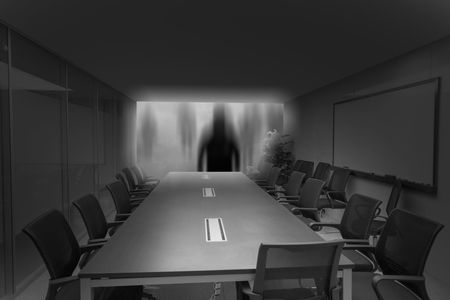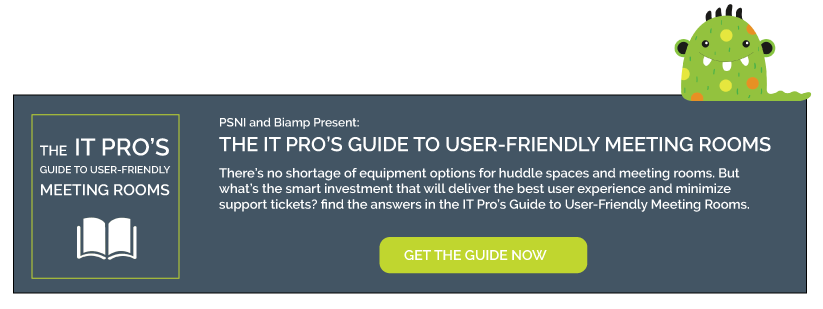Technology is never as terrifying as Hollywood portrays it—from obsessed killer cars to dimensional travel televisions—but if you work in tech, you’ve likely experienced a few horror stories of your own. This Halloween, we asked IT pros to share their most chilling and mysterious conference room tales. Please enjoy these short stories based on their experiences. Stick around to the end where our integration experts weigh in with advice and tips.
Broken Cables
I remember it was early. On the agenda was a video conference scheduled with the overseas team. All the big names are here. There was the excited buzz of voices that quieted as the organizer moved to start the video conference. Seconds seemed like minutes. Minutes felt like hours. There was no image. There – was – no – image! The screen is as dark as a cemetery at midnight.
The room feels like it is getting colder as I hunt for the cause. There is an HDMI cable that runs behind the cabinet, across the floor (covered), and up to the conference table. Someone from the night before must have pulled on the HDMI cable too hard and now it’s damaged beyond repair.
Failure is not an option. I set up a Skype meeting for the overseas people and used the projector in the room (for local people)—and it worked. I ran the new HDMI cable a few days later.
The Connector
It was an ordinary workday—busy and very fast-paced. One of the partners at my firm needed to do a video conference through Skype. I’d already configured Skype to run on the smart TV in the conference room. Unbeknownst to me, there was a mysterious development. Like Jimmy Hoffa, the Skype app had vanished without a trace.
Turns out the smart TV manufacturer stopped supporting Skype and removed the app during the last OS update. We tried to run Skype on the attorney’s laptop but it kept crashing. The forces were against us that day. We finally turned to the only remaining device that would run Skype—an associate’s iPhone. Luckily the meeting was for an intern interview, but to be reduced to an iPhone to conduct a professional interview? Terrifying indeed.
Voices in the Dark
It should have been easy—using the video phone appliances in our two offices. They are VoIP phones with a built in HDMI cable and associated IP camera, so you can do “instant” video chats. Just dial the other phone, turn on the TV and you are video conferencing.
Not so. These phones are about as popular with our employees as Dorothy was with the monkeys of Oz. While they’d like to blame the phones—labeling them inferior technology—99 percent of the time it’s a keyboard-to-chair-interface issue. The problem is always in the remote office and we’re a one-man IT shop, so I’m rarely there.
The last time I was at the remote office, I discovered that the whole reason we weren’t getting video feed was that someone had unplugged the HDMI cable! The issue was the HDMI feed is converted to Cat5E via transmitter/receiver in the walls. They had checked that the HDMI cable was still connected at the phone, but someone must have caught the other end with their foot and pulled it out of the transmitter. Too bad you can’t fix users as easily.
The Witches of WiFi
What horrifies me is our Internet connection. There is simply not enough signal strength to use WiFi in our meeting room. Inevitably, this problem occurs when I’m not there but another team and my CEO are. The other team is not only the victim but the perpetrator of Internet woes.
Here are the details: The room is set up with one iMac and a 40-inch display. It should always be connected to the wired LAN. But this other team always connects using WiFi. Then, when it doesn’t work, they call me in front of the CEO to complain. Sigh.
So I disconnect the WiFi, connect back to the LAN. After a few minutes, they call back to tell me the Internet is not working. And it’s because they’ve again connected to the WiFi to make their call. They’re gaslighting me right? Or am I slowly going mad?
Blind Image
It was the day I was demoing a new document camera software for my department and boss. I was prepped. I was excited. I fired up my presentation but no image. Yep, I forgot to check everything out the day before and that day, the day of my presentation, I realized that the video switcher had died. My temporary solve was Frankenstein-esque mess of cable and adapters across the room to get the image to the projector. Lesson learned: always do a trial run before a scheduled presentation.
Excerpts from the Diary of Unreasonable Requests
March 7, 2017. Now they want bright, large projection images. From a tiny projector that doesn’t throw off heat or have a fan. “They’re putting projectors in phones! I saw one on YouTube!”
June 12, 2017. Today they asked me to change our 120″ projection solution to a TV. But they don’t want a smaller screen and they don’t want to pay more than what a 65-70″ TV costs. “Can’t you just put two 60″ TVs together to get a 120″ and make one of those TV walls?” September 21, 2017. Today’s gem. They want a teleconferencing solution using cheap webcams, but expect big, clear picture on the other end where we can see the faces of the other party (like they’re on the other end of a big table). And they want to simultaneously show Excel or PowerPoint content. But don’t use two TVs. Oh, and they want TWO other offices on the call with our HQ.
September 21, 2017. Today’s gem. They want a teleconferencing solution using cheap webcams, but expect big, clear picture on the other end where we can see the faces of the other party (like they’re on the other end of a big table). And they want to simultaneously show Excel or PowerPoint content. But don’t use two TVs. Oh, and they want TWO other offices on the call with our HQ.
How to Exorcise Conference Tech Issues—AV Integration Experts Share Insights
Discover Cable Issues Before the Meeting
A network-based system can be set up to detect issues like disconnected or broken cables immediately. Had the issue been known, it seems there may have been enough time to fix it prior to the meeting time. In a networked system, an alert gets emailed to the designated IT contact and tells you the connection is down. This enables you to solve it before everyone is staring at the screen the next morning.
— Mike Kirby, Director, Business Development and Marketing, GENCOMM
Skype, When and How You Want
There are many conference/collaboration options on the market. If Skype is your go-to conference solution, take advantage of all the benefits Skype has to offer. Consider integrating a Microsoft Surface Hub into your infrastructure. The Microsoft Surface Hub is not only the best in class for collaboration and conferencing, it’s the device that will best suit an organization committed to Skype.
— Justin Rogina, Customer Success Manager, Spinitar
Correct User-Caused Issues
To remedy user experience issues like the LAN to WiFi connection, it’s best to walk through the issues one by one with an AV expert. Our process is to tackle the immediate need—get the meeting running—first. Then we recommend a site visit where our technician can do a more thorough investigation of the issues.
— Javed Wahid, MIS Team Leader, Spinitar
Journey Back to Reality
Dealing with uninformed and unrealistic requests is just a matter of education. We go through these things daily with our clients and thanks to all the high-tech gadgets on TV (that don’t actually exist), we get unbelievable requests all the time! We educate our customers on what is out there and the pros and cons of each choice. We find the best option in most cases is to bring in demos. This allows the end user to see if they will really be happy with their choice.
— Mike Kirby, Director, Business Development and Marketing, GENCOMM
Want More?
If you like this blog and want more helpful insights from PSNI affiliated integrators, don’t forget to subscribe. To find an integrator near you, use our Find an Integrator tool.










